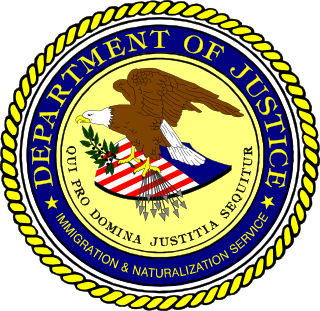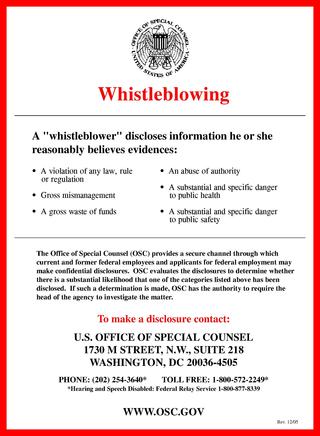Related Research Articles

The United States Department of Labor (DOL) is one of the executive departments of the U.S. federal government. It is responsible for the administration of federal laws governing occupational safety and health, wage and hour standards, unemployment benefits, reemployment services, and occasionally, economic statistics. It is headed by the Secretary of Labor, who reports directly to the President of the United States and is a member of the president's Cabinet.

The Bureau of Labor Statistics (BLS) is a unit of the United States Department of Labor. It is the principal fact-finding agency for the U.S. government in the broad field of labor economics and statistics and serves as a principal agency of the U.S. Federal Statistical System. The BLS collects, processes, analyzes, and disseminates essential statistical data to the American public, the U.S. Congress, other Federal agencies, State and local governments, business, and labor representatives. The BLS also serves as a statistical resource to the United States Department of Labor, and conducts research measuring the income levels families need to maintain a satisfactory quality of life.

The United States Immigration and Naturalization Service (INS) was an agency of the U.S. Department of Labor from 1933 to 1940 and the U.S. Department of Justice from 1940 to 2003.
The Occupational Safety and Health Administration is a regulatory agency of the United States Department of Labor that originally had federal visitorial powers to inspect and examine workplaces. The United States Congress established the agency under the Occupational Safety and Health Act, which President Richard M. Nixon signed into law on December 29, 1970. OSHA's mission is to "assure safe and healthy working conditions for working men and women by setting and enforcing standards and by providing training, outreach, education, and assistance." The agency is also charged with enforcing a variety of whistleblower statutes and regulations. OSHA's workplace safety inspections have been shown to reduce injury rates and injury costs without adverse effects on employment, sales, credit ratings, or firm survival.
The Job Training Partnership Act of 1982 was a United States federal law passed October 13, 1982, by Congress with regulations promulgated by the United States Department of Labor during the Ronald Reagan administration. The law was the successor to the previous federal job training legislation, the Comprehensive Employment and Training Act (CETA). It was repealed by the Workforce Investment Act of 1998 during the administration of President Bill Clinton.

The United States Women's Bureau (WB) is an agency of the United States government within the United States Department of Labor. The Women's Bureau works to create parity for women in the labor force by conducting research and policy analysis, to inform and promote policy change, and to increase public awareness and education.
The Commission on Protecting and Reducing Government Secrecy, also called the Moynihan Commission, after its chairman, U.S. Senator Daniel Patrick Moynihan, was a bipartisan statutory commission in the United States. It was created under Title IX of the Foreign Relations Authorization Act for Fiscal Years 1994 and 1995 to conduct "an investigation into all matters in any way related to any legislation, executive order, regulation, practice, or procedure relating to classified information or granting security clearances" and to submit a final report with recommendations. The Commission's investigation of government secrecy was the first authorized by statute since the Wright Commission on Government Security issued its report in 1957.

The President's Commission on the Status of Women (PCSW) was established to advise the President of the United States on issues concerning the status of women. It was created by John F. Kennedy's Executive Order 10980 signed December 14, 1961. In 1975 it became the National Association of Commissions for Women.

Overseas Filipino Worker (OFW) is a term often used to refer to Filipino migrant workers, people with Filipino citizenship who reside in another country for a limited period of employment. The number of these workers was roughly 1.77 million between April and September 2020. Of these, female workers comprised a larger portion, making up 59.6 percent, or 1.06 million. However, this number declined to 405.62 thousand between 2019 and 2020.
Right to know is a human right enshrined in law in several countries. UNESCO defines it as the right for people to "participate in an informed way in decisions that affect them, while also holding governments and others accountable". It pursues universal access to information as essential foundation of inclusive knowledge societies. It is often defined in the context of the right for people to know about their potential exposure to environmental conditions or substances that may cause illness or injury, but it can also refer more generally to freedom of information or informed consent.
Wider Opportunities for Women (WOW) is a national nonprofit organization in the United States established in 1962 by Jane Fleming and Mary Janney in Washington, D.C.
The New York State Department of Labor is the department of the New York state government that enforces labor law and administers unemployment benefits.
President Dwight D. Eisenhower issued Executive Order 10450 on April 27, 1953. Effective May 27, 1953, it revoked President Truman's Executive Order 9835 of 1947, and dismantled its Loyalty Review Board program. Instead, it charged the heads of federal agencies and the Civil Service Commission, supported by the Federal Bureau of Investigation (FBI), with the task of investigating federal employees to determine whether they posed security risks. It expanded the definitions and conditions used to make such determinations. The order contributed to the ongoing Lavender scare of the mid-1950s, barring thousands of lesbian and gay applicants from government jobs.

A whistleblower is a person who exposes any kind of information or activity that is deemed illegal, unethical, or not correct within an organization that is either private or public. The Whistleblower Protection Act was made into federal law in the United States in 1989.
The Fair Employment Practice Committee (FEPC) was created in 1941 in the United States to implement Executive Order 8802 by President Franklin D. Roosevelt "banning discriminatory employment practices by Federal agencies and all unions and companies engaged in war-related work." That was shortly before the United States entered World War II. The executive order also required federal vocational and training programs to be administered without discrimination. Established in the Office of Production Management, the FEPC was intended to help African Americans and other minorities obtain jobs in home front industries during World War II. In practice, especially in its later years, the committee also tried to open up more skilled jobs in industry to minorities, who had often been restricted to lowest-level work. The FEPC appeared to have contributed to substantial economic improvements among black men during the 1940s by helping them gain entry to more skilled and higher-paying positions in defense-related industries.

The Wisconsin Department of Workforce Development (DWD) is an agency of the Wisconsin state government responsible for providing services to Wisconsin workers, employers, and job-seekers to meet Wisconsin's workforce needs. To effect its mission, the Department administers unemployment benefits and workers' compensation programs for the state of Wisconsin; ensures compliance with state laws on wages and discrimination; provides job resources, training, and employment assistance for job-seekers; and engages with employers to help them find and maintain adequate staffing for their businesses.

The Workforce Innovation and Opportunity Act (WIOA) is a United States public law that replaced the previous Workforce Investment Act of 1998 (WIA) as the primary federal workforce development legislation to bring about increased coordination among federal workforce development and related programs.
Dislocated worker funding is typically used to help workers in events of mass employment loss. A dislocated or displaced worker is defined as an individual who has been laid off or received notice of a potential layoff and has very little chance of finding employment in their current occupation when attempting to return to the workforce. Displaced workers are most frequently found in the manufacturing industry. Legislation addressing training for these workers was first introduced in 1959 through the passing of the Area Redevelopment Act of 1959. Over the years, legislation funding these programs has included wording holding states and private businesses accountable for the roles in the dislocation of workers. Due to the importance of this funding and the negative economic impact of displaced workers, the United States has passed continuing legislation as recent as 2014 and 2015.
CETA Employment of Artists(1974–1981) refers to the Comprehensive Employment and Training Act (CETA), which federally employed more than 10,000 artists – visual, performing, and literary – during a span of eight years. This was the largest number of artists supported by Federal funding since the Works Progress Administration (WPA) of the 1930s. It is estimated that an additional 10,000 arts support staff were funded as well. During its peak year, 1980, CETA funding for arts employment funneled up to $300 million into the cultural sector – and the economy – of the United States. In comparison, the National Endowment for the Arts budget that year was $159 million.
References
- 1 2 3 National Commission for Employment Policy authority record from the National Archives and Records Administration. Accessed March 7, 2014.
This article is based on public-domain material from the National Archives and Records Administration, an agency of the United States government.